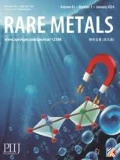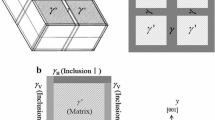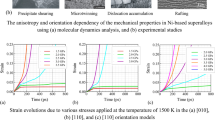Abstract
This paper is focused on developing suitable methodology for predicting creep characteristics (i.e., the minimum creep strain rate, stress rupture life and time to a specified creep strain) of typical Ni-based directionally solidified (DS) and single-crystal (SC) superalloys. A modern method with high accuracy on simulating wide ranging creep properties was fully validated by a sufficient amount of experimental data, which was then developed to model anisotropic creep characteristics by introducing a simple orientation factor defined by the ultimate tensile strength (UTS). Physical confidence on this methodology is provided by the well-predicted transitions of creep deformation mechanisms. Meanwhile, this method was further adopted to innovatively evaluate the creep properties of different materials from a relative perspective.








Similar content being viewed by others
References
Scholz A, Wang Y, Linn S. Modeling of mechanical properties of alloy CMSX-4. Mater Sci Eng A. 2009;510(10):278.
Liu H, Xuan FZ. A new model of creep rupture data extrapolation based on power processes. Eng Fail Anal. 2011;18(8):2324.
Harrison W, Whittaker M, Williams S. Recent advances in creep modelling of the nickel base superalloy, alloy 720Li. Materials. 2013;6(3):1118.
Lin YC, Xia YC, Chen MS. Modeling the creep behavior of 2024-T3 Al alloy. Comput Mater Sci. 2013;67:243.
Tamura M, Esaka H, Shinozuka K. Stress and temperature dependence of time to rupture of heat resisting steels. ISIJ Int. 1999;39(4):380.
Wilshire B, Scharning PJ. A new methodology for analysis of creep and creep fracture data for 9 %–12 % chromium steels. Int Mater Rev. 2008;53(2):91.
Wilshire B, Scharning PJ, Hurst R. New methodology for long term creep data generation for power plant components. Mater Sci Eng Energy Syst. 2007;2(2):84.
Li SX, Ellison EG. The influence of orientation on the elastic and low cycle fatigue properties of several single crystal nickel base superalloys. J Strain Anal Eng Des. 1994;29(2):147.
Han GM, Yu JJ, Sun YL. Anisotropic stress rupture properties of the nickel-base single crystal superalloy SRR99. Mater Sci Eng A. 2010;527(21):5383.
Yuan C, Guo JT, Yang HC. Deformation mechanism for high temperature creep of a directionally solidified nickel-base superalloy. Scripta Mater. 1998;39(7):991.
China Aeronautical Materials Handbook Editorial Board. China Aeronautical Materials Handbook, vol. 2. 2nd ed. Beijing: Standards Press of China; 2002. 113.
Meng XL. Microstructure and creep behaviours of DZ125 nickel based superalloy. Shenyang: Shenyang University of Technology; 2012. 145.
Yuan C, Guo JT, Yang HC. Effect of grain boundary orientation and cyclic load on creep and fracture behaviour in directionally solidified nickel base superalloy. Mater Sci Tech Lond. 2002;18(1):73.
Ibanez AR, Srinivasan VS, Saxena A. Creep deformation and rupture behaviour of directionally solidified GTD 111 superalloy. Fatigue Fract Eng Mater. 2006;29(12):1010.
Gordon AP. Crack Initiation modeling of a directionally-solidified nickel-base superalloy. Atlanta: Georgia Institute of Technology; 2006. 123.
Ibanez AR. Modeling creep behavior in a directionally solidified nickel base superalloy. Atlanta: Georgia Institute of Technology; 2003. 75.
MacLachlan DW, Knowles DM. Modeling and prediction of the stress rupture behaviour of single crystal superalloys. Mater Sci Eng A. 2001;302(2):275.
Ma A, Dye D, Reed RC. A model for the creep deformation behaviour of single-crystal superalloy CMSX-4. Acta Mater. 2008;56(8):1657.
Woodford DA. Parametric analysis of monocrystalline CMSX-4 creep and rupture data. Metall Mater Trans A. 1998;29(10):2645.
Monkman FC, Grant NJ. An empirical relationship between rupture life and minimum creep rate in creep-rupture tests. Proc ASTM. 1956;56:593.
Mukherjee AK, Bird JE, Dorn JE. Experimental correlations for high-temperature creep. Trans ASM. 1969;62:155.
Evans M. Prediction of long-term creep rupture data for 18Cr–12Ni–Mo steel. Int J Press Vessels Pip. 2011;88(11):449.
Liu JL, Jin T, Sun XF. Anisotropy of stress rupture properties of a Ni base single crystal superalloy at two temperatures. Mater Sci Eng A. 2008;479(1):277.
Whittaker MT, Harrison WJ, Lancaster RJ. An analysis of modern creep lifing methodologies in the titanium alloy Ti6-4. Mater Sci Eng A. 2013;577(15):114.
Sajjadi SA, Nategh S. A high temperature deformation mechanism map for the high performance Ni-base superalloy GTD-111. Mater Sci Eng A. 2001;307(1):158.
Reed RC. The Superalloys: Fundamentals and Applications. Cambridge: Cambridge University Press; 2006. 154.
Acknowledgments
This research was financially supported by the National Natural Science Foundation of China (No. 51275023) and the Innovation Foundation of BUAA for Ph.D. Graduates (No. YWF-14-YJSY-49).
Author information
Authors and Affiliations
Corresponding author
Rights and permissions
About this article
Cite this article
Huang, J., Shi, DQ. & Yang, XG. A physically based methodology for predicting anisotropic creep properties of Ni-based superalloys. Rare Met. 35, 606–614 (2016). https://doi.org/10.1007/s12598-015-0544-z
Received:
Revised:
Accepted:
Published:
Issue Date:
DOI: https://doi.org/10.1007/s12598-015-0544-z




